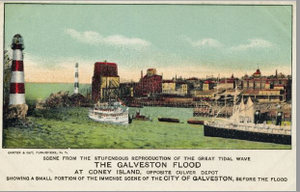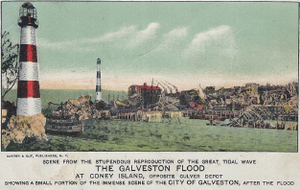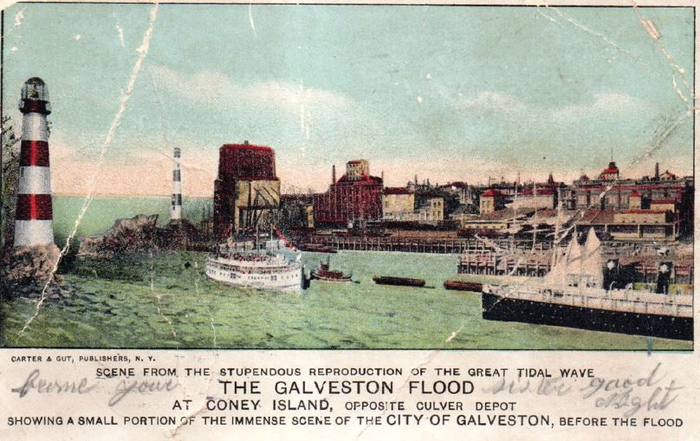Today, when we hear about a tragedy or major
news event, we don’t need to go any further than our televisions, computers or
phones to find endless details and videos of the occurrence. People in years
past were no less inquisitive, but with motion pictures still in their infancy
and limited newspaper photographs, their curiosity was often less than
satisfied.
The
Great Storm of 1900 Strikes Coney Island,
New York
At the turn of the century, New
York’s famous Coney Island had
plenty of showmen who were happy to capitalize on this somewhat morbid
curiosity by providing visual spectaculars that immersed the viewer into
reenactments of the world’s greatest calamities. In those days, visitors to Luna Park on
Coney Island could take make-believe journeys
around the world and experience recreations of the massive disasters they had read
about in the news or in books.
On any given day, one could witness a staging
of the Boer War featuring real Boer War veterans, a recreation of the
destruction of Pompeii by its legendary volcanic
blast, relive the frightening effects of a San Francisco
earthquake, or view a village of the headhunting Bontac tribe of the Philippines
with actual tribesmen on display.
Among the
earliest of these shows was the “Galveston Flood,” created in 1902 by the
Imperial Amusement Company to re-enact the horrors of the 1900 Great Storm,
which had killed thousands of people here in Galveston only two years earlier.
In the show’s opening year, the Broadway
Weekly gave the “Galveston Flood” rave reviews, stating, “In all the years
that ambitious efforts have been made to reproduce historical scenes, there has
never been anything which approaches such perfection, in realization of all the
harrowing details, as the Electro-Aqua Scenic-Mechanical Exhibition of the
Galveston Flood at Coney Island.”
 The show was housed
in an immense white building on Surf
Avenue, which dwarfed the surrounding structures.
The auditorium stage, said to be the largest in the country at the time,
measured 125 feet wide by 90 feet deep.
The show was housed
in an immense white building on Surf
Avenue, which dwarfed the surrounding structures.
The auditorium stage, said to be the largest in the country at the time,
measured 125 feet wide by 90 feet deep.
Galveston and its harbor were meticulously
recreated in miniature with intricate lighting, individual model buildings,
working railroad cars, streetcars and ships all electrically powered to portray
the goings-on of an average workday. The mechanics required a large
amount of electricity and were so advanced for their time that they were
featured in national electrician magazines of the day.
Each half-hour,
crowds poured into the auditorium to witness the tragedy for themselves. As a
narrator explained the sequence of events, visitors would watch the progression
of the storm, hundreds of buildings being washed away by torrential rains and
wind, and fires erupting among the ruins of the city.
Audiences watched with terror and excitement
as actors portraying Galvestonians risked their lives to rescue fellow victims,
and parents sacrificed their lives to save children. The force of the show’s
waters was quite treacherous, and during at least one performance workers were
hurt badly enough to have to close the show and rescue the injured, making the
news the next morning.
 On
August 16, 1904 the New York Times
reported a special one-time addition to the show. “The managers of the
Galveston Flood Coney Island entertained 50 Texans yesterday. Three of them are
survivors of the big deluge that destroyed so many lives in Galveston a couple of years ago. One of the
three replaced the lecturer for a few minutes and told about his experiences at
the time of the flood.”
On
August 16, 1904 the New York Times
reported a special one-time addition to the show. “The managers of the
Galveston Flood Coney Island entertained 50 Texans yesterday. Three of them are
survivors of the big deluge that destroyed so many lives in Galveston a couple of years ago. One of the
three replaced the lecturer for a few minutes and told about his experiences at
the time of the flood.”
At the end of each
performance, crowds left the building with the complex model in a state of
apparent demolition, and rushed to purchase “before” and “after” scenes from the
show on postcards to send home. Massive electric pumps then drained the water
from the stage and the city was “reborn” for the next audience.
 For those patrons who had not witnessed
enough destruction, the owners of the Galveston
exhibit even offered free shuttle service over to the “Johnstown Flood”
disaster show.
For those patrons who had not witnessed
enough destruction, the owners of the Galveston
exhibit even offered free shuttle service over to the “Johnstown Flood”
disaster show.
The “Galveston Flood” structure survived the
devastating Coney Island fire in 1911 and spent
its last remaining years as a dime museum and arcade. It was eventually demolished
in the 1950s to make way for the aquarium that is located on the same spot to
this day- the New York Aquarium.
The
Great Storm Engulfs the 1904 St. Louis
World’s Fair
Two
years after Coney Island debuted the “Galveston Storm,” the 1904 World’s Fair
in St. Louis followed
the trend with its own version. Located in the Pike area of the fairgrounds,
the exhibit, which opened on May 20, was designed by E.J. Austin and took 100
people to operate the mechanical and electrical effects.
For just
25¢ adult admission and 15¢ for
children, families could witness the catastrophe every hour of the day. As it
was at Coney Island, the city was recreated in
miniature and was destroyed by the forces of wind and water amid flashes of
lightening and thunder. A man narrated the events in melodramatic tones, while
a young lady played mood music on a piano set at the side of the stage. Only
the gruesome deaths were omitted from this performance.
One
major difference occurred in the St. Louis show
that hadn’t drawn attention on Coney Island:
Galvestonians took issue with the fact that the show ended on such a
downtrodden tone.
C. R.
Kitchell and John Reymershoffer, representing the Galveston Chamber of
Commerce, and George Sealy, representing the Galveston Business League, went to
St. Louis and attended two performances of the
“Galveston Storm” and alleged that it did not represent Galveston as rehabilitated and improved. The
city representatives specifically cited that the new Seawall was depicted as
shorter than it actually was.
 According
to the Galveston Daily News on June
25, 1904, the show management agreed to make some improvements and additions to
avoid litigation over the matter. “Mr. Kitchell said that the management
received the committee very cordially and expressed themselves desirous of
doing everything possible to represent Galveston
in its true light. The also offered to insert any statements in the lecture or
eliminate any feature the committee deemed improper. The management agreed to
build the balance of the wall and also to show Galveston as it will appear when the grade is
raised.”
According
to the Galveston Daily News on June
25, 1904, the show management agreed to make some improvements and additions to
avoid litigation over the matter. “Mr. Kitchell said that the management
received the committee very cordially and expressed themselves desirous of
doing everything possible to represent Galveston
in its true light. The also offered to insert any statements in the lecture or
eliminate any feature the committee deemed improper. The management agreed to
build the balance of the wall and also to show Galveston as it will appear when the grade is
raised.”
By the next day, when the
three men attended a show at the invitation of the management, an entirely new
ending had been scripted, complete with uplifting music and the appearance of a
painting of the rejuvenated city at the end of the performance. The changes
seemed to be popular ones with the audiences as well, and the exhibit brought a
profit of nearly $200,000 for investors.
Whether considered morbid
curiosity or the “need to know,” human nature hasn’t changed much in the last
century. Crowds still flock to learn all the grisly details about tragedies
such as the sinking of the Titanic or
to view Ground Zero in Manhattan.
The catastrophe of the Great Storm of 1900 proved to be just the ticket for
out-of-state amusement event managers seeking a profit, as well as for curious
crowds seeking horrors and thrills.